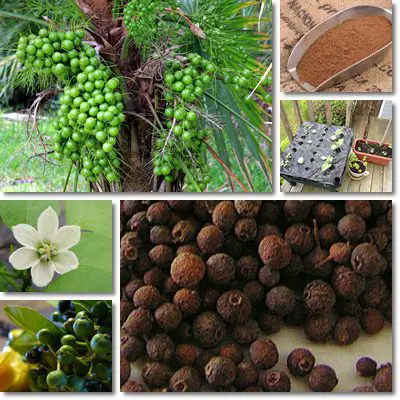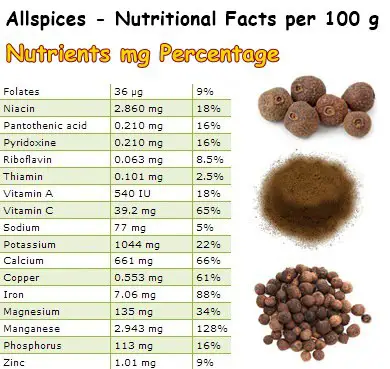Native to Jamaica, allspice (Pimenta dioica) is an incredibly popular spice in Caribbean, Mexican, American and Middle Eastern cuisine. In addition to being used to spice up stews, meats, cakes and other sweets, allspice contributes greatly to keeping us in good health. The dried berries are a generous source of B vitamins and vitamin C and quite rich in potent minerals such as manganese, potassium, magnesium, iron, copper, calcium and phosphorus.
Regular consumption is said to help digestion, regulate intestinal motility and transit time, contribute to bone and teeth health and offer antioxidant protection. Moreover, the spice boasts mild cardio-protective properties, contributing to good blood pressure levels and supporting muscle activity, heart muscle included. Other benefits derived from the vitamin and mineral content of the spice include improved energy metabolism and brain and nervous system health.

What is allspice and what does it look like?
Allspice or Jamaican pepper is a type of culinary spice native to Jamaica. It is made from the dried, unripe (green) berry-fruit of the allspice shrub. Fresh allspice fruit and leaves can both be used for seasoning food. However, the leaves tend to lose most of their flavor when dried which is why they are only used locally, where trees offer a constant supply of fresh leaves.
While allspice fruit look a lot like dried, large, brown or reddish-brown peppercorns (hence their other popular names such as Jamaica pepper, myrtle pepper, English pepper or pimento, pimenta), allspice leaves are quite similar in appearance to bay leaves (laurel).
What does allspice taste like?
The reason why this Jamaican native pepper has been called allspice is because it tastes like a combination of several spices, namely pepper, nutmeg, cloves and cinnamon. For this reason you might want to check the label very carefully when purchasing the spice because some allspice products are actually a combination of other spices and merely replicate the taste, despite the label saying otherwise. Also, know that allspice (pimento, pimenta or Pimenta dioica) is not the same thing as pimiento (large, red chilly pepper, Capsicum annuum species).
Side effects and contraindications of Allspice
It goes without saying that allspice should be consumed with moderation, just like any other spice. Ingesting too much (excessive amounts) can have several unpleasant or potentially serious side effects such as irritated stomach mucosa, acid reflux with heartburn, inflammation of the stomach lining (gastritis), stomach ulcers and even convulsions. Also, some people may have an innate hypersensitivity to the spice, in which case it should be excluded from their diet in order to prevent severe allergic reactions.

What are the benefits of allspice?
Find out below what allspice is good for to make the best use of its properties and benefits:
Excellent antiseptic properties
Allspice contains eugenol, a great natural antiseptic and sedative. Allspice essential oil, for example, not only relaxes muscles due to its mild sedative properties, but also helps prevent infection caused by bacteria of fungi present on the skin. However, make sure not to consume excessive amounts of allspice because eugenol is also a hepatotoxic agent and may have unpleasant secondary effects.
Offers antioxidant protection
Allspice is rich in antioxidants such as vitamin C, copper, manganese, polyphenols such as tannins and flavonols such as quercetin, all of which boast great antioxidant properties. Copper and manganese, for example, are cofactors for the superoxide dismutase enzyme, our body’s natural defense against free radical cell damage. Antioxidants not only prevent and counteract oxidative stress, but also help reduce inflammation caused by it, resulting in a better protection against chronic disease.
Good digestion aid
According to research, natural compounds in allspice contribute to good digestion by increasing gastric enzymes secretion. Moreover, it is believed that allspice consumption can help regulate intestinal transit time and improve motility. This holds other benefits as well, such as constipation relief.

Tonic properties
Rich in minerals, allspice is quite the tonic-spice. If you take a look at the nutrition table above, you will see that it provides 128% of the RDA of manganese, 88% iron, 66% calcium, 61% copper, 34% magnesium and 22% potassium. Magnesium and potassium for example promote cardiovascular health. While potassium regulates body fluids and blood pressure levels, magnesium supports the activity of muscles such as the heart (cardiac) muscle.
However, for faster and more visible results, you might want to include other potassium and magnesium-rich foods in your diet, preferably vegetables and fruits or nuts and seeds which you can consume in larger amounts. Just remember to check for allergies to nuts and seeds first.
Helps prevent anemia
Being a rich source of iron (88%), allspice contributes to the prevention of anemia caused by iron deficiency. However, it is important to introduce other iron-rich foods into our diet because allspice, despite being a rich source of the nutrient, is something we can only eat in limited amounts and thus cannot help us meet our daily requirements. Including vitamin C-rich foods into our diets further helps by enhancing iron absorption, especially that of non-heme iron from plant sources which is generally not as well absorbed.
Promotes strong bones
Although consumption is limited, allspice helps meet dietary demands of calcium, phosphorus and magnesium, three minerals of great importance for strong, healthy bones and teeth. The fourth, vitamin D, is supplied by sun exposure.
Conclusion
While eating chard, potatoes, papaya, lentils, beans, spinach, sesame seeds, cabbage, bell peppers, kiwifruit, kale, Brussels sprouts, carrots and so on will supply you with far greater amounts of most essential nutrients, seasoning your food with allspice and other spices will add to your nutrition status and antioxidant intake, and the health benefits you enjoy as a result.
